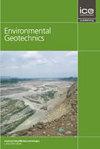Short-Term Predictions of Evaporation Using SoilCover at the Near-Surface of a Mine Waste Pile following Heavy Rainfall Events
IF 2.2
4区 工程技术
Q3 ENGINEERING, GEOLOGICAL
引用次数: 0
Abstract
Accurate measurements and predictions of near-surface soil drying and evaporation following heavy rainfall events are often needed for research in agriculture and hydrology. However, such measurements and predictions at mine waste pile and tailing settings are limited. The prediction of evaporation at mine waste piles is essential for many problems in geotechnical engineering, including the design of soil cover systems for the long-term closure of hazardous waste sites, and thus mitigates, for example, the generation of acid mine drainage (AMD) and metal leaching. AMD is one of mining’s most serious threats to the environment. This study investigated the short-term (8 days) and medium-term (27 days) drying rates and evaporative fluxes at the surface and near-surface of the Deilmann South waste-rock (DSWR) pile at the Key Lake uranium mine, northern Saskatchewan, using the gravimetric (GV) method and SoilCover (SC) model, respectively, during and following heavy rainfall events for the environment. The SC simulation results showed that during the weather-controlled stage (Stage I) of the first 5-day period of rainfall events, while the surface was wet, the potential evaporation (PE) was equal to the actual evaporation (AE) (i.e., AE/PE = 1). As the surface became drier on Day 6, the cumulative PE began to separate from the cumulative AE and the surface’s drying rate rapidly diverged from those at the deeper depths. This occurrence signaled the onset of the soil profile property-controlled stage (Stage II). As the drying continued, the surface became desiccated and the slow-rate drying stage (Stage III) was established from Day 7 onward. The SC-simulated AE results were compared to those measured using the eddy covariance (EC) method for the same test period at the DSWR pile in a different study. The comparison showed that the two methods yielded similar AE results, with 18% relative errors. The results of this study provided the opportunity to validate the SC model using actual data gathered under field conditions and to ascertain its ability to accurately predict the PE and AE at the surfaces of mine waste piles.利用土壤覆盖对强降雨后矿山废渣堆近地表蒸发的短期预测
农业和水文学研究经常需要对强降雨事件后近地表土壤的干燥和蒸发进行准确的测量和预测。然而,这种测量和预测在矿山废渣堆和尾矿设置是有限的。矿山废物堆蒸发的预测对于岩土工程中的许多问题,包括为长期关闭危险废物场址而设计土壤覆盖系统,是必不可少的,从而减轻例如酸性矿山排水和金属浸出的产生。AMD是采矿业对环境最严重的威胁之一。本研究分别采用重力(GV)方法和土壤覆盖(SC)模型,对萨斯喀彻温省北部Key Lake铀矿山Deilmann South废石堆(DSWR)地表和近地表短期(8天)和中期(27天)的干燥速率和蒸发通量进行了研究。SC模拟结果表明,在降水事件前5 d的天气控制阶段(第1阶段),地表湿润时,潜在蒸发量(PE)与实际蒸发量(AE)相等(AE /PE = 1),随着第6天地表变干,累积PE开始与累积AE分离,地表干燥速率与深层干燥速率迅速偏离。这一现象标志着土壤剖面属性控制阶段(阶段II)的开始。随着干燥的继续,表面变得干燥,从第7天开始建立慢速干燥阶段(阶段III)。将sc模拟的声发射结果与另一项研究中使用涡动相关(EC)方法在DSWR桩相同测试周期测量的声发射结果进行了比较。结果表明,两种方法的声发射结果相似,相对误差为18%。本研究的结果为SC模型在现场条件下收集的实际数据进行验证提供了机会,并确定了其准确预测矿山废堆表面PE和AE的能力。
本文章由计算机程序翻译,如有差异,请以英文原文为准。
求助全文
约1分钟内获得全文
求助全文
来源期刊

Environmental geotechnics
Environmental Science-Water Science and Technology
CiteScore
6.20
自引率
18.20%
发文量
53
期刊介绍:
In 21st century living, engineers and researchers need to deal with growing problems related to climate change, oil and water storage, handling, storage and disposal of toxic and hazardous wastes, remediation of contaminated sites, sustainable development and energy derived from the ground.
Environmental Geotechnics aims to disseminate knowledge and provides a fresh perspective regarding the basic concepts, theory, techniques and field applicability of innovative testing and analysis methodologies and engineering practices in geoenvironmental engineering.
The journal''s Editor in Chief is a Member of the Committee on Publication Ethics.
All relevant papers are carefully considered, vetted by a distinguished team of international experts and rapidly published. Full research papers, short communications and comprehensive review articles are published under the following broad subject categories:
geochemistry and geohydrology,
soil and rock physics, biological processes in soil, soil-atmosphere interaction,
electrical, electromagnetic and thermal characteristics of porous media,
waste management, utilization of wastes, multiphase science, landslide wasting,
soil and water conservation,
sensor development and applications,
the impact of climatic changes on geoenvironmental, geothermal/ground-source energy, carbon sequestration, oil and gas extraction techniques,
uncertainty, reliability and risk, monitoring and forensic geotechnics.
 求助内容:
求助内容: 应助结果提醒方式:
应助结果提醒方式:


